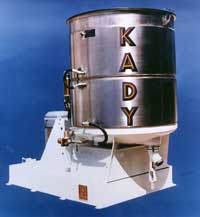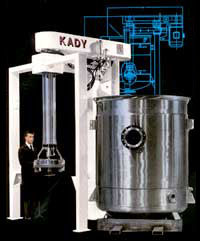High Speed Production Mills
The KADY® Mill is an efficient, high speed dispersion mill capable of quickly reducing agglomerates to their ultimate particle size, and efficiently producing fine dispersions, suspensions and high quality emulsions. KADY® Mills can disperse, emulsify, suspend, cook, aerate, and deaerate. Lab, pilot and production mills are available in top entry or bottom entry models and range in size from one pint to 2,000 gallons batch (or 3 to 500 gallons per minute continuous flow-see Continuous Flow Mills.) All mills may be specifically engineered to your specifications with options including variable frequency for mixing speed and temperature, vacuum and pressure abilities, sweep arm, cooled mixing shafts, and jacketed vessels, to name only a few.
The KADY® operates on a principal of impact and attrition utilizing a slotted rotor inside a slotted stator. Acting as a centrifugal pump, the KADY® forces material through the radial slots and hurls it off the slot tips at 9,000 feet per minute against the stator slots. This produces efficient wetting-out of the solid phase and stable suspensions, dispersions and emulsions are quickly achieved.
The KADY® is sometimes used in concert with other mixers and mills (see KADY® Premilling,) but most dispersions can be completed in ONE STEP. The KADY® often eliminates the need for pre-mix and post mix letdown.
How the KADY Mill Works
The KADY Mill operates by pumping material through radial slots in a high speed rotor and propelling it at tip speeds up to 9,000 ft/min into the staggered slots of a stationary stator. This concentrated impact and attrition produce aggressive wetting, rapid deagglomeration, and efficient particle breakage. Because the mechanism delivers high energy per pass, many formulations reach their final dispersion in a single step, eliminating the need for separate premix or let down stages and shortening production cycles.
Applications and Process Flexibility
KADY mills are used across coatings, inks, adhesives, food, pharmaceuticals, and chemical processing where consistent particle size and stable suspensions are required. The platform supports a broad viscosity range and high solids slurries, and can be configured for specialized tasks such as cooking or deaeration. Lab, pilot, and production variants preserve the same rotor/stator dynamics so process development translates predictably to full scale.
Options and Engineered Features
Production mills may be customized with variable frequency drives for precise speed control, temperature monitoring and jacketed vessels for thermal management, vacuum or pressure capability for deaeration or sealed processing, sweep arms for improved bulk movement, and cooled shafts for temperature sensitive chemistries. Material-of construction choices and hardened wear parts extend life when processing abrasive pigments or corrosive media.
Scale-Up Confidence and Lab Support
All KADY lab and pilot tests correlate to production units because the core rotor/stator geometry and tip speeds are maintained across sizes. KADY offers free lab testing so you can validate dispersion targets, energy-per-pass, and heat generation on your actual formulations. Lab results provide the empirical data needed to size production equipment and reduce scale up risk.
Typical Models and Operating Ranges
KADY bottom entry and top entry production models cover a wide range of batch volumes and rotor speeds to match process needs, from small, high tip speed units for fine pigments to large, lower speed units for high volumes. Model selection is based on operating volume, desired rotor tip speed, and horsepower requirements to achieve target particle-size distribution and throughput.
Frequently Asked Questions
What Advantages Does a KADY Mill Offer Over Traditional Batch Mixers?
Kady mills deliver higher energy and more efficient wetting, often allowing single-step dispersions that eliminate premix and let-down, reducing cycle time and labor.
How Do I Choose the Right Model for My Production Volume?
Select a model whose recommended operating volume overlaps your typical batch size and energy input needed for your target particle size; use lab trials to confirm performance.
Can the Mill Be Configured for Temperature Control or Vacuum Operation?
Yes, units can be supplied with jacketed vessels, temperature monitoring, and vacuum or pressure capabilities to support degassing, heating, or sealed processing.
Are Lab Test Results Predictive of Full-Scale Performance?
Yes, because rotor/stator geometry and tip speeds are maintained across scales, lab trials correlate closely with pilot and production units, providing reliable scale-up data.
Free lab test services are available to test your mixing process, and all results in the Kady test lab correlate to the entire line of KADY® lab, pilot and production mills.



